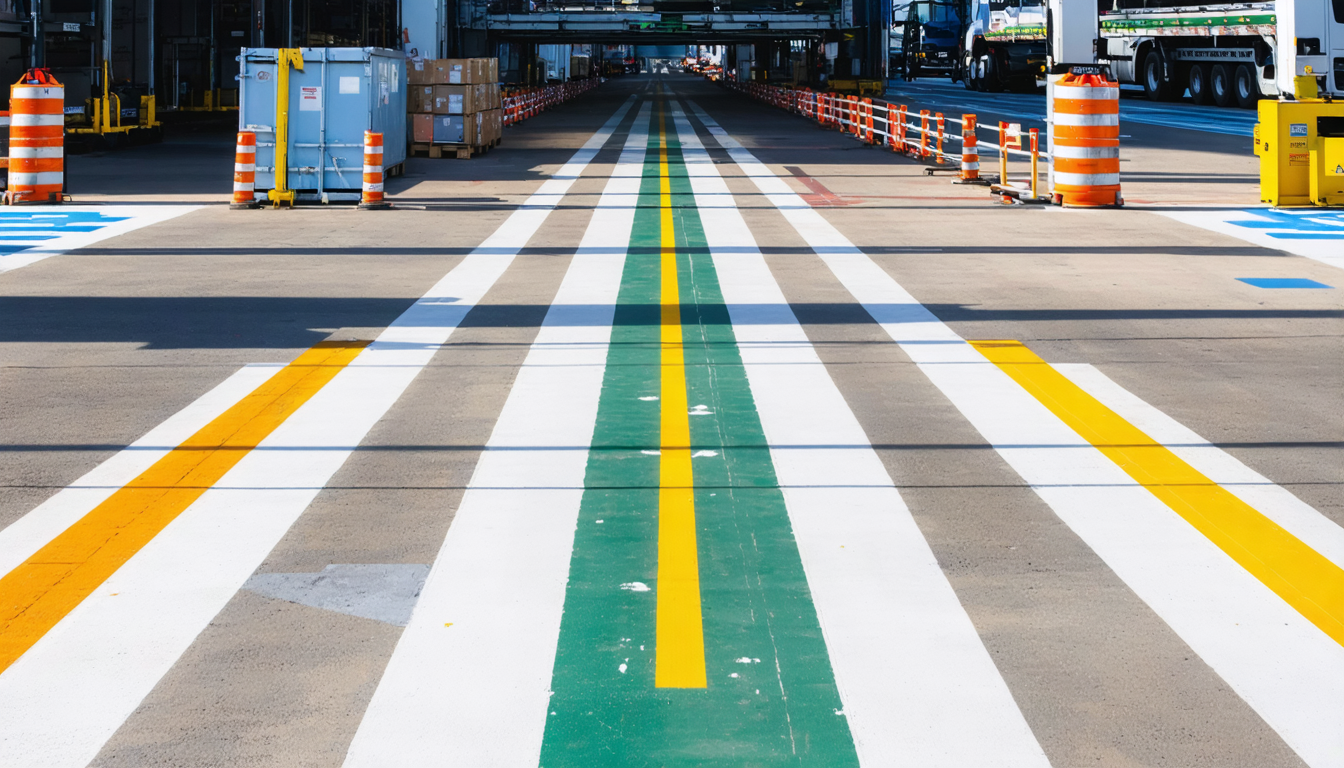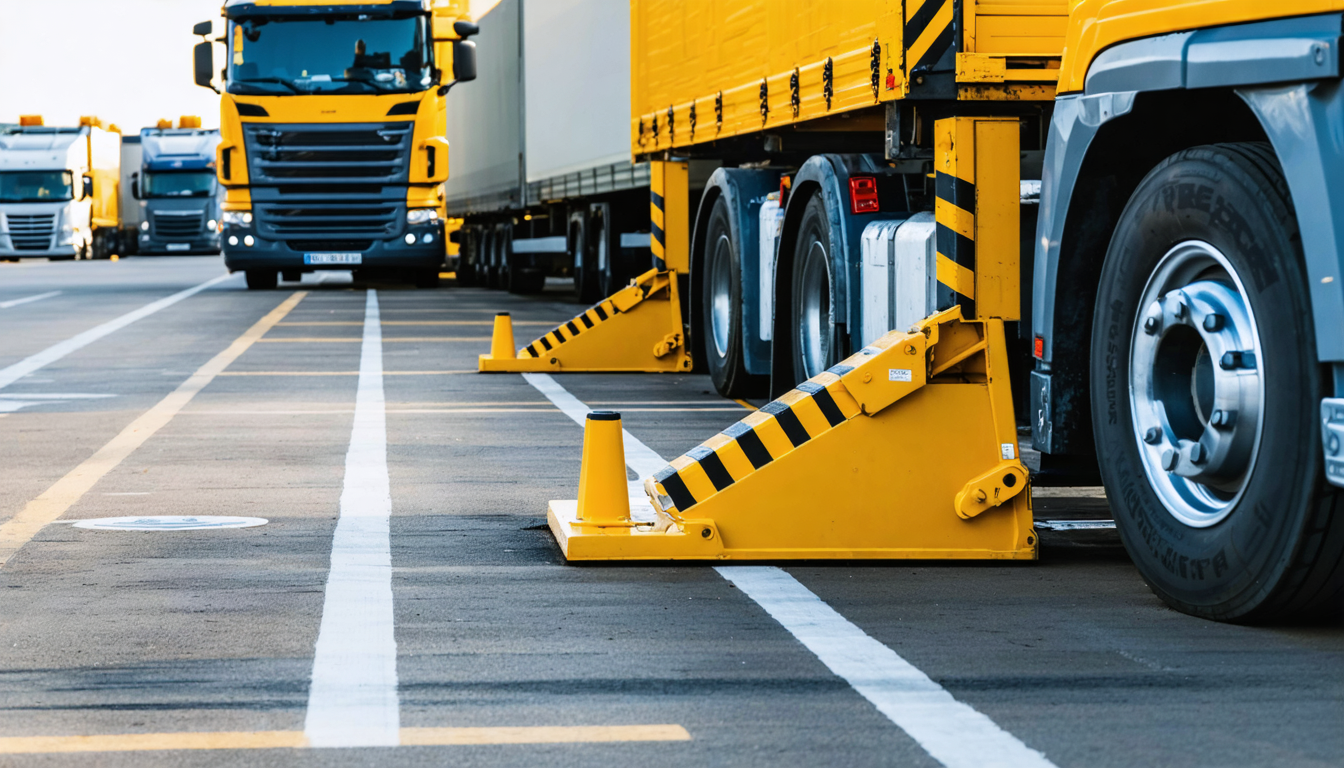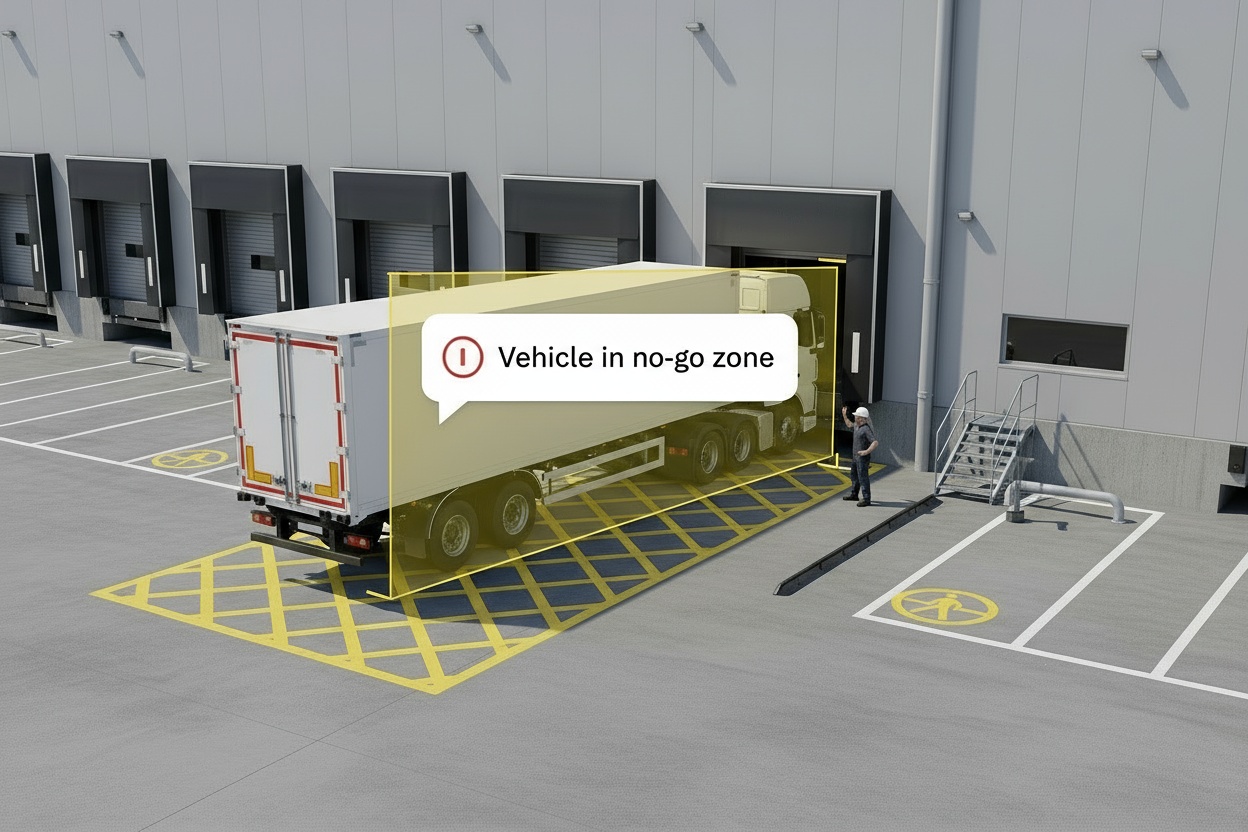Injuries in U.S. warehouses and logistics yards are an obstacle, with events involving heavy equipment like forklifts being a major concern. Each occurrence brings a cascade of costs, including direct medical expenses, workflow disruptions, added administrative workload, and the pressure to keep operations moving on tight schedules.
The good news? Most vehicle collisions in yard and dock operations are avoidable. By combining proven safety protocols with capable video AI, logistics leaders can move from investigating after the fact to actively reducing risk. This guide breaks down the costs and root causes of yard and dock vehicle collisions and provides a practical framework for risk reduction—empowering your team to keep people safe and business running.
Why vehicle collisions in yard and dock operations are a major risk for logistics
Vehicle collisions in yards and docks are a substantial risk to uptime, worker safety, and operational flow. These events often involve heavy equipment like forklifts, semi-trucks, and yard tractors operating in close proximity to pedestrians and other vehicles.
The dangers are amplified by:
High pedestrian and vehicle traffic in confined spaces.
Blind spots and poor visibility at busy docks and cross-aisles.
Trailer movement (“trailer creep”) during loading/unloading.
Fatigue and time pressure on operators.
Design flaws—narrow aprons, congested drive lanes, and inadequate signage.
Severe injuries, such as amputations and crush injuries, are common in yard and dock events. The most frequently injured body parts are legs, fingertips, and feet, usually from being pinned or struck by vehicles or equipment.
The top 5 causes of vehicle collisions in yard and dock operations—and how to mitigate them
Understanding why these events occur is the first step toward mitigation. Here are the leading causes, with actionable strategies that blend hands-on protocols with the power of video AI.
1. Poor Traffic Flow and Congestion
The Hazard:
In a congested yard, a yard tractor may swing wide to avoid obstacles while a forklift operator navigates a tight space. These situations, often complicated by blind spots and unclear traffic rules, frequently lead to collisions.
Traditional Mitigation:
Painted lines and physical barriers to separate vehicles and pedestrians.
Scheduled loading/unloading windows to reduce peak congestion.
Manual spotters and traffic marshals during busy periods.
How Video AI Enhances Mitigation:
Video AI can detect when vehicles enter no-go zones or bottlenecks form, alerting supervisors to adjust operations. This monitoring identifies where and when congestion peaks, so teams can adjust traffic routes, loading schedules, or staffing to reduce risk. Explore video AI solutions.
2. Inadequate Pedestrian-Vehicle Separation

The Hazard:
When pedestrian walkways are not clearly defined or respected, workers can inadvertently step into active vehicle lanes. A forklift operator focused on a maneuver may not see the pedestrian, creating a hazardous situation for a collision.
Traditional Mitigation:
Designated, painted pedestrian walkways and crossing points.
Training workers to make eye contact with drivers before crossing.
Warning signage and audible alarms on vehicles.
How Video AI Enhances Mitigation:
Video AI can flag when people enter restricted or vehicle-only zones, sending alerts to supervisors or operators. Over time, analytics reveal patterns, helping safety teams pinpoint high-risk locations and times to reinforce training. Discover pedestrian safety analytics.
3. Failure to Use or Maintain Vehicle Restraints

The Hazard:
If a trailer is not properly secured, it can creep away from the dock during loading or unloading. This movement creates a dangerous gap that can lead to forklift collisions, a danger that increases when wheel chocks or restraints are not used.
Traditional Mitigation:
Mandatory use of wheel chocks, dock locks, and vehicle restraints for every load.
Supervisor walkthroughs to check compliance.
Training and signage to reinforce the importance of securing every trailer.
How Video AI Enhances Mitigation:
Video AI can monitor loading zones for vehicle movement during operations, flagging when a vehicle enters a no-go zone or a trailer departs prematurely. Alerts help teams intervene immediately, stopping unsafe situations before they become incidents. See how video AI helps avert incidents.
4. Operator Distraction, Speeding, or Fatigue
The Hazard:
Operator behavior, such as distraction from handheld devices, speeding to meet schedules, or fatigue from long shifts, substantially increases collision risk. These factors can lead to missed stop signs or a failure to notice other vehicles and pedestrians.
Traditional Mitigation:
Enforcement of speed limits and anti-idling policies.
Operator training focused on situational awareness and safe speeds.
Random spot checks and peer observations for distraction and fatigue.
How Video AI Enhances Mitigation:
By analyzing video for unsafe behaviors, such as running or vehicles entering no-go zones, video AI can flag hazards as they happen. Reviewable footage supports coaching and targeted retraining, which helps reinforce accountability.
5. Blind Spots and Poor Visibility
The Hazard:
Environmental factors like fog, poorly lit corners, and obstructions from stacked pallets create major blind spots. These conditions make routine maneuvers hazardous, as a driver may not see a worker or another vehicle.
Traditional Mitigation:
Regular lighting checks and upgrades in yards and docks.
Use of high-visibility PPE and reflective tape on vehicles.
Convex mirrors and manual spotters for blind zones.
How Video AI Enhances Mitigation:
Video AI can monitor for running and crowding in low-visibility areas, surfacing unsafe behavior or unexpected movement. The resulting data helps facilities teams prioritize lighting upgrades and redesign layouts to eliminate blind spots.
Integrating a video AI camera system: from NVR to AI insights for logistics safety
For many logistics teams, upgrading safety tech can sound daunting, especially if it means replacing old systems or retraining staff from scratch. However, current video AI platforms are built for easy integration.
Feature | Traditional NVR System | AI Camera Platform (Cloud NVR) |
|---|---|---|
Camera Compatibility | Requires proprietary hardware | Works with existing POE/legacy cams |
Storage | On-premise servers | Secure, cloud-native, scalable |
Maintenance | Frequent, on-site | Minimal, remote updates |
User Access | Limited seats | Unlimited users, unified dashboard |
Video Review | Manual, slow | AI-powered search & incident alerts |
Actionable Insights | Passive footage | Alerts for no-go zones, running, and crowding |
A cloud-based video AI system overlays analytics onto your current video feeds, with no need for a full rip-and-replace. It evolves passive monitoring into a proactive tool, automatically flagging unauthorized zone entries or other unsafe behaviors. With unlimited user seats and a unified dashboard, safety becomes a shared responsibility across your team.
Practical tips for implementation:
Confirm camera compatibility—current video AI platforms work with nearly all POE cameras.
Prioritize solutions that overlay analytics (like vehicle enters no-go zones, forklift enters no-go zones, and running) on your existing camera setup.
Integrate with your existing safety and training programs—use video data for targeted coaching, incident reviews, and compliance audits.
Choose cloud-native solutions to reduce on-premises hardware, lower maintenance, and enable secure, scalable access for your team.
By aligning your tech upgrade with your broader safety strategy, you empower everyone—from the loading dock to the C-suite—to contribute to a safer, more efficient operation.
Make every yard and dock safer—partner for proactive safety
Every yard or dock collision is a chance to improve. By putting video AI at the center of your safety program, you can boost compliance, and give your team the tools to stop the next incident before it happens.
Ready to build a more forward-looking safety program? Book a safety consultation with Spot AI’s experts and get actionable, site-specific guidance to improve your operations. Book a safety consultation.
Frequently asked questions
What are the most common causes of vehicle collisions in logistics yards and docks?
The leading causes are poor traffic flow and congestion, inadequate separation between vehicles and pedestrians, failure to use vehicle restraints, operator distraction or fatigue, and blind spots or poor visibility.
How can logistics organizations implement safety technology without disrupting operations?
Current video AI platforms overlay analytics on your existing camera network, requiring no major infrastructure changes. They enable hazard detection and reporting, supporting staff rather than replacing them.
What compliance standards should logistics organizations follow for yard and dock safety?
Organizations should follow standards from the Occupational Safety and Health Administration, which mandate requirements like operator training, equipment maintenance, and the use of vehicle restraints (Source: OSHA). Additionally, industry standards like ANSI MH30.1 provide detailed guidance on dock safety equipment and protocols (Source: ANSI).
What practical steps should be taken before adopting AI video analytics in logistics?
Start with a risk assessment to identify high-traffic or hazardous zones. Involve IT, safety, and operations teams early. Pilot the AI platform in a known problem area, measure incident reductions, and expand based on results.
How does AI-powered video support incident investigations?
Video AI platforms automatically flag events—such as a vehicle or forklift entering a no-go zone—making it quick to review footage, pinpoint root causes, and support thorough OSHA and insurance investigations.
How can safety technology help reduce stress for safety leaders?
Video AI automates routine monitoring and reporting, freeing safety leaders to focus on training, coaching, and proactive improvements—instead of responding to every event after the fact.
What features define an effective video analytics system for workplace safety?
An effective system should work with your existing cameras to avoid costly replacement. Look for a cloud-native platform that offers a unified dashboard for scalable, remote access. The most valuable systems provide specific, actionable alerts for behaviors like 'no-go zone' entries, 'running,' and 'crowding' to help you proactively address risks.
About the author
Joshua Foster
IT Systems Engineer, Spot AI
Joshua Foster is an IT Systems Engineer at Spot AI, where he focuses on designing and securing scalable enterprise networks, managing cloud-integrated infrastructure, and automating system workflows to enhance operational efficiency. He is passionate about cross-functional collaboration and takes pride in delivering robust technical solutions that empower both the Spot AI team and its customers.

























.png)
.png)
.png)